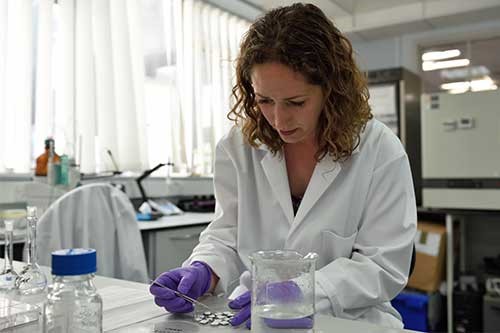A team of researchers at the University of Bristol led by Dr Barbour, School of Oral and Dental Sciences, has recently developed a new sustained efficacy antimicrobial material that can kill harmful bacteria such as MRSA and C. difficile. The material Pertinax, which was patented by the University, acts as a slow release device for the common biocide chlorhexidine.
Chlorhexidine is widely used in human and veterinary healthcare, and is effective against many bacteria and yeasts. In its commercially available form its efficacy and applications are limited by the fact that it is highly soluble which means it is quickly removed from the area it is applied to, and high concentrations and/or regular re-application is required to give any sustained protection against infection.
The new material developed by Dr Barbour and her team at the University of Bristol acts as a slow release device for chlorhexidine, and when incorporated into medical devices such as wound care materials can protect against infection for extended periods.
The development of antimicrobial wound care products incorporating chlorhexidine as the active agent is a priority area for medical device manufacturers specialising in Advanced Wound Management.
A Knowledge Transfer (TRACK) award from the Elizabeth Blackwell Institute enabled Dr Barbour to form a new collaboration with a major wound care material manufacturer to address the important question of how the material responds to sterilisation. Medical devices such as wound care products need to be sterile before they enter the body, to reduce chances of infection. If antimicrobial material is changed by sterilisation – if it becomes less effective for example – this would inform the range of applications that it can be used for.
Dr Barbour, working with Dr Maddocks, Cardiff Metropolitan University, established that the two forms of sterilisation most commonly used for medical devices, ethylene oxide gas sterilisation and gamma irradiation sterilisation, had no effect on the antimicrobial efficacy of the material. Heating above 200°C, however, caused the material to break down. Since the former two methods of sterilisation are the most common used in wound care material manufacture, this indicates that sterilisation should not be a barrier to the application of this material in such products.
Alongside the important work carried out at the spin-out, which focusses on scale up and commercial applications, the research group have now moved on to investigate the use of the antimicrobial material to protect neonates in developing countries from umbilical cord infection. This condition, while rare in developed countries, is a major problem in low resource settings and there is not an adequate ‘single application’ strategy.
Dr Barbour said: ‘Working with collaborators in Pakistan and an NGO who specialise in the introduction of emerging technologies to low resource settings, as well as with a team based in Sheffield and Bristol, we are developing a topical product that can be applied just once to the infant’s umbilical cord and which will protect against infection for the critical first few days of life.’
